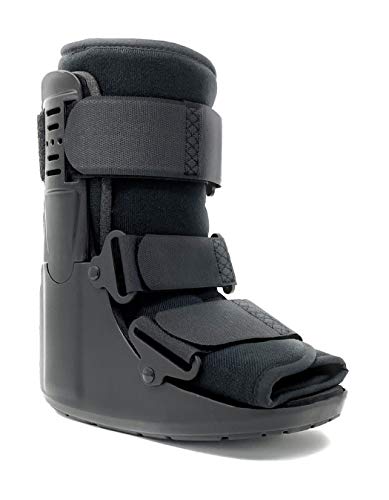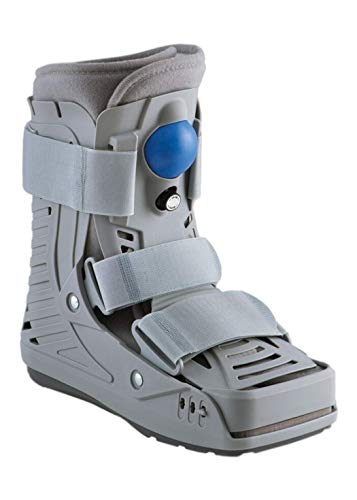- Sticks, Canes & Crutches
- Our Quality Guarantee
- Last Updated October 20, 2023

How to Choose the Best Walking Boot for a Broken Foot or Ankle? (Different Types Compared)
The walking boot or cast has become a popular medical equipment due to its frequent and common use for treating bone breaks, injuries, and fractures. The walking cast, which also includes stabilizers, air casts, or walking boots, is specifically designed to immobilize specific regions along the ankle and leg. By immobilizing the calf, ankle, foot, or all three, walking boots are mainly used to stop the injured parts from moving while keeping the affected parts in place to promote more effective and faster healing.
Since walking boots treat many types of injuries or conditions, they come in various shapes, constructions, specialties, and sizes. The most common sub-categories include air cast boots, soft or stiff casts, ankle casts, low-tops, and high-tops. Here is more information on a few essential considerations you should be making when determining the specifications or features you will need from a walking boot.
In This Article
Essential Features for Optimal Recovery
Cast Size
While this may be the most apparent consideration to keep in mind, it is worth noting that walking boots come in many different sizes, which mainly correspond or match up to measurements of your foot or your shoe size while taking the added bulk into account the cast itself. It is essential to look at available sizing options for every walking boot you are interested in. Most of these products come with sizing charts to help you find the right walking boot. One of the most important parts of promoting adequate and faster healing is to make sure you choose the right-sized boot so that it provides the proper immobilization and support.
| Your Shoe Size | Corresponding Size | |
| Men’s US shoe size | Women’s US shoe size | |
| – | 4 -6 | XS |
| 6- 8 | 6.5 – 9 | S |
| 8.5 – 10.5 | 9.5 – 11.5 | M |
| 11 – 13.5 | 12+ | L |
Anti-Shock Technology
Anti-shock technology is an innovative feature that is made available in a few of the walking boots. While just about all walking boots provide some cushioning impact, a few products take this one step further by implementing anti-shock designs that lower the risks of further injuries. Specific anti-vibration and anti-shock cast or sole constructions are beneficial, especially when you have a great deal of discomfort or pain caused by a broken or injured foot.
Strap Types
While most walking boots use Velcro straps to secure your cast, other options exist. Some products, especially cast shoes or smaller boots, can use non-Velcro-based straps or clasps for fastening. While this may be a minor consideration or concern, reviewing what type of straps the product features might be worthwhile if you have a specific preference or find it difficult to fasten smaller clasps.
Boot Or Cast Liners
The inside of a walking boot often includes a liner that can be made from different materials. Most of these products feature comfortable, supportive, and soft liners. There are also many options available when it comes to liners, with some preferable when it comes to weather conditions or your specific condition or injury. For this reason, reviewing the interior lining and whether replacement linings are available should your lining wear down may be worthwhile.
Supports
Some of the walking boots also include added supports that are typically made from metals or dense plastics. These supports add additional support to your leg. This type of support is more common in the Air Cast Boots or high-top walking boots that usually require an added degree of vertical stability when you need more mobility.
Different Types of Walking Boots
Walking casts or boots are treatment devices for various conditions or injuries linked to the lower leg, ankle, and foot. Here is an overview of the main types and the specific types and conditions they are designed for.
Detailed Comparison of Features by Boot Type
| Features | Low-Top Walking Boots | High-Top Walking Boots | Air Cast Walking Boots | Hard Cast Bottoms and Shoes |
|---|---|---|---|---|
| Ankle Support | Minimal | Excellent | Adjustable | Minimal |
| Protection Level | Basic | High | Moderate | Basic |
| Comfort | High | Moderate due to rigidity | High, adjustable comfort | Varies |
| Mobility | High | Reduced due to added support | Moderate | High |
| Ventilation | Excellent | Moderate | Good | Good |
| Adjustability | Limited | Good | Excellent, customizable | Limited |
| Application | Minor injuries, post-surgery | Severe injuries, stability needs | Moderate injuries, versatility | Over hard casts, protection |
Low-Top Walking Boots
Low-top walking boots, characterized by their design extending just above the ankle or to the lower calf, are essential in treating specific lower leg and foot injuries. They are engineered with features that cater to individuals’ comfort, support, and mobility needs, recuperating from mild to moderate injuries.
Key Features
- Targeted Support:
- Low-top walking boots are specially designed to offer targeted support to the heel, lower ankle, or foot, making them ideal for injuries localized in these areas.
- Their structure ensures that the affected area receives the necessary support without compromising the mobility of the upper ankle and leg.
- Enhanced Comfort:
- These boots often come with padded interiors and adjustable straps, ensuring a snug fit and enhanced comfort for prolonged wear.
- The design allows for adequate ventilation, ensuring that the foot remains cool and dry.
- Design Excellence:
- It encapsulates the foot and lower ankle, providing targeted support and stabilization.
- It’s crafted with user comfort in mind, ensuring wearers can do their daily activities with minimal inconvenience.
- Application:
- This specific boot is instrumental in healing fractures and injuries affecting the foot and lower ankle. Its design ensures immobilization of the injured area, reducing movement and promoting faster healing.
- The adjustable nature allows for swelling fluctuations, ensuring the boot remains comfortable and effective throughout recovery.
Considerations for Use
- Injury Assessment:
- It’s crucial for individuals considering low-top walking boots to have their injuries thoroughly assessed by a professional to ensure that this type of support is appropriate.
- These boots are optimal for specific injuries and may not offer adequate support for more complex or severe injuries involving the upper ankle or leg.
- Lifestyle Adaptation:
- Wearers often find that adapting to the low-top walking boot is relatively straightforward, given its design that balances support with mobility.
- The boots are typically lightweight, making them a convenient option for individuals seeking to maintain a degree of normalcy in their daily routines while recovering.
With their targeted support and enhanced comfort features, low-top walking boots stand as a reliable option for individuals recovering from foot, heel, or lower ankle injuries. Adaptation, comfort, and support are at the forefront of the design philosophy for low-top walking boots, exemplified by models like the United Ortho Short Cam Walker Fracture Boot.
At a Glance:
- Pros: Offers significant comfort and excellent ventilation, ideal for minor injuries and post-operative recovery.
- Cons: Limited ankle support and adjustability.
Popular Example: United Ortho Short Cam Walker Fracture Boot
High-Top Walking Boot
High-top walking Boots are often the first visual that comes to mind when “walking boots” are mentioned. Renowned for their robust design and comprehensive support, these boots are a standard recommendation for various leg and foot injuries.
Key Features
- Comprehensive Support
- Enclosed Design: High-top walking boots envelop the leg from the mid-calf to toe, ensuring support and stability.
- Material Composition: A cushioned inner layer ensures comfort, while a rigid outer shell of metal and plastic blend offers durability.
- Injury Application: Ideal for calf or ankle injuries, delivering targeted support for quicker recovery.
- Adjustability and Customization
- Adaptive Fit: These boots, though sturdy, are adjustable to fit snugly, adapting to changes in the injured area’s size during recovery.
- Ventilation: Their design balances robust support with ventilation to minimize skin irritations and maximize comfort.
Limitations: Mobility Challenges
- Weight: High-top walking Boots offer comprehensive support but can be heavy, potentially restricting movement.
- Comfort: The boots are cushioned, yet their necessary rigidity for optimal support may affect comfort during prolonged wear.
Practical Applications: Healing and Recovery
- Professional Recommendation: These boots are typically prescribed for moderate to severe injuries requiring enhanced support.
- Daily Activities: They facilitate mobility during everyday tasks, offering a blend of support and functionality for healing.
High-top walking Boots stand as a testament to the balance between rigorous support and user adaptability. While they boast undeniable benefits in injury stabilization and healing acceleration, considerations regarding comfort and mobility are essential.
Aircast AirSelect Walker Walking Boot is a good example of this type of walking cast.
At a Glance:
- Pros: Provides superior ankle support and protection, making it suitable for severe injuries requiring enhanced stability.
- Cons: It can be less comfortable and limit mobility due to its rigid structure.
Air Cast Walking Boots
The Air Cast Boot is a modern alternative to traditional low-top or high-top walking boots and casts. It’s designed with innovative features that offer enhanced comfort and support for individuals recovering from minor injuries.
Key Features of the Air Cast Boot
- Enhanced Comfort and Support:
- Air cushions provide a snug, comfortable fit.
- Easily adjustable for tailored support.
- Increased Mobility:
- Designed for quicker healing and enhanced movement.
- Offers more than support; aids efficient recovery.
- Flexibility:
- It functions as a cast and walking aid.
- Easily removable for convenience and breathability.
Limitations
- Not for Severe Injuries
- The Air Cast Boot is tailored for minor injuries.
- It isn’t suitable for healing severe conditions like fractured bones or damaged ligaments, where a hard cast is essential.
- Transitional Use
- This boot is a common choice during the transition from a hard cast to no cast.
- It provides a mix of protection and flexibility, aiding the injured leg’s gradual recovery.
The Air Cast Boot is convenient, comfortable, and flexible for individuals with minor injuries. While it offers enhanced mobility and comfort, it’s not suitable for severe injuries requiring a hard cast’s rigid support.
At a Glance:
- Pros: Features adjustable air cells for customized support and comfort, making them versatile for various injuries.
- Cons: Offers moderate protection compared to high-top variants.
Some popular examples of this product include United Ortho Short Air Cam Walker Fracture Boot and United Ortho Tall Air Cam Walker Fracture Boot.
Hard Cast Bottoms and Shoes
Hard Cast Bottoms and Shoes serve a distinct purpose in injury recovery. Unlike the robust support and protection offered by other types of walking boots, these specialized “shoes” focus on safeguarding the hard cast itself. Let’s delve into their features, applications, and limitations.
Key Features
- Protective Layer
- Hard Cast Shoes serve as a protective barrier for the foot part of a hard cast.
- Their primary function is to guard the cast against daily wear and tear, not to provide additional support.
- Durability: Built for resilience, these shoes ensure the cast stays undamaged, enduring regular movement and contact with surfaces.
- Ease of Use: Their simple design ensures they are easy to put on and take off, adding a layer of convenience to the recovery process.
Applications
- Daily Protection: Perfect for active individuals, it safeguards the hard cast during daily tasks, preventing scuffs or damage.
- Indoor and Outdoor Use: These versatile shoes offer cast protection indoors and outdoors against different surfaces and elements.
Limitations
- Limited Support:
- It’s crucial to understand that Hard Cast Shoes provide minimal support to the foot or ankle. Their primary role is protection, not support.
- Specific Application:
- These are specifically meant for individuals with a hard cast, not a standalone solution for injury support or mobility.
Hard Cast Bottoms and Shoes are invaluable accessories for individuals with a hard cast, acting as a protective barrier against damage during daily movements. While they lack the support and cushioning of other walking boots, their role in preserving the integrity of the hard cast is essential.
At a Glance:
- Pros: Designed to be worn over hard casts, offering protection and enabling mobility.
- Cons: Primarily protect the cast, with minimal additional support or protection for the injury.
Consult a Doctor for the Ideal Walking Boot for Your Injury
Since there are notable varieties of walking boots, you should always consult a doctor to help you find a device that matches your needs. If you have a broken foot or a foot injury, your doctor can advise you on how to care for your injuries with the proper medications and the correct walking boot to promote faster and more efficient healing.
CAM Boot vs Walking Boot?
“CAM Boot,” aka Controlled Ankle Motion Boot, and “Walking Boot” are often used interchangeably, but they can refer to different types of medical boots designed to support and protect your foot and ankle.
| Feature/Criteria | CAM Boot | Walking Boot |
|---|---|---|
| Purpose | Severe injuries, post-surgery | Moderate injuries like sprains, fractures |
| Design | Rigid framework | Semi-rigid or soft shell |
| Adjustability | Straps with optional dials for micro-adjustments | Basic straps |
| Weight | Heavier (3-5 lbs) | Lighter (2-4 lbs) |
| Cost | More expensive ($50-$250) | More affordable ($20-$120) |
| Terrain Compatibility | Best for indoor or smooth outdoor surfaces | Versatile for both indoor and outdoor use |
| Air/Foam Compartments | Usually present for custom pressure and support | May or may not have |
| Special Features | Rocker bottom for natural walking motion | Generally lacks advanced features like rocker bottoms |
| Who Should Use It | Individuals with severe injuries or post-operative conditions | Individuals with moderate or mild injuries |
Alternatives Compared to Walking Boots
If a walking boot isn’t quite right for your needs or comfort, consider these alternative mobility aids that can also provide support, stability, and pain relief during your recovery.
- Walking Boots offer a well-rounded mix of support, comfort, and protection for various injuries.
- Crutches are portable but can be uncomfortable and offer less stability.
- Knee Scooters excel in mobility and comfort but can be bulky.
- Canes are simple and ideal for minor injuries but offer limited support.
- Leg Braces provide targeted support but are less protective compared to walking boots.
The differences between walking boots and their alternatives
| Features | Walking Boots | Crutches | Knee Scooters | Canes | Leg Braces |
| Support Level | High | Medium | Medium | Low | Medium |
| Mobility | Moderate | Low | High | Moderate | High |
| Comfort | High | Low | High | Medium | Medium |
| Ease of Use | Easy | Moderate | Easy | Easy | Moderate |
| Protection of Injured Area | Excellent | Good | Good | Fair | Good |
| Versatility | High | Medium | Low | High | Medium |
| Transportability | Easy | Easy | Difficult | Easy | Easy |
Making the Right Choice
While alternatives like crutches, knee scooters, canes, and leg braces have unique benefits, walking boots stand out for their all-around support, protection, and stability for various injuries.
Articles You May be Interested In:






























